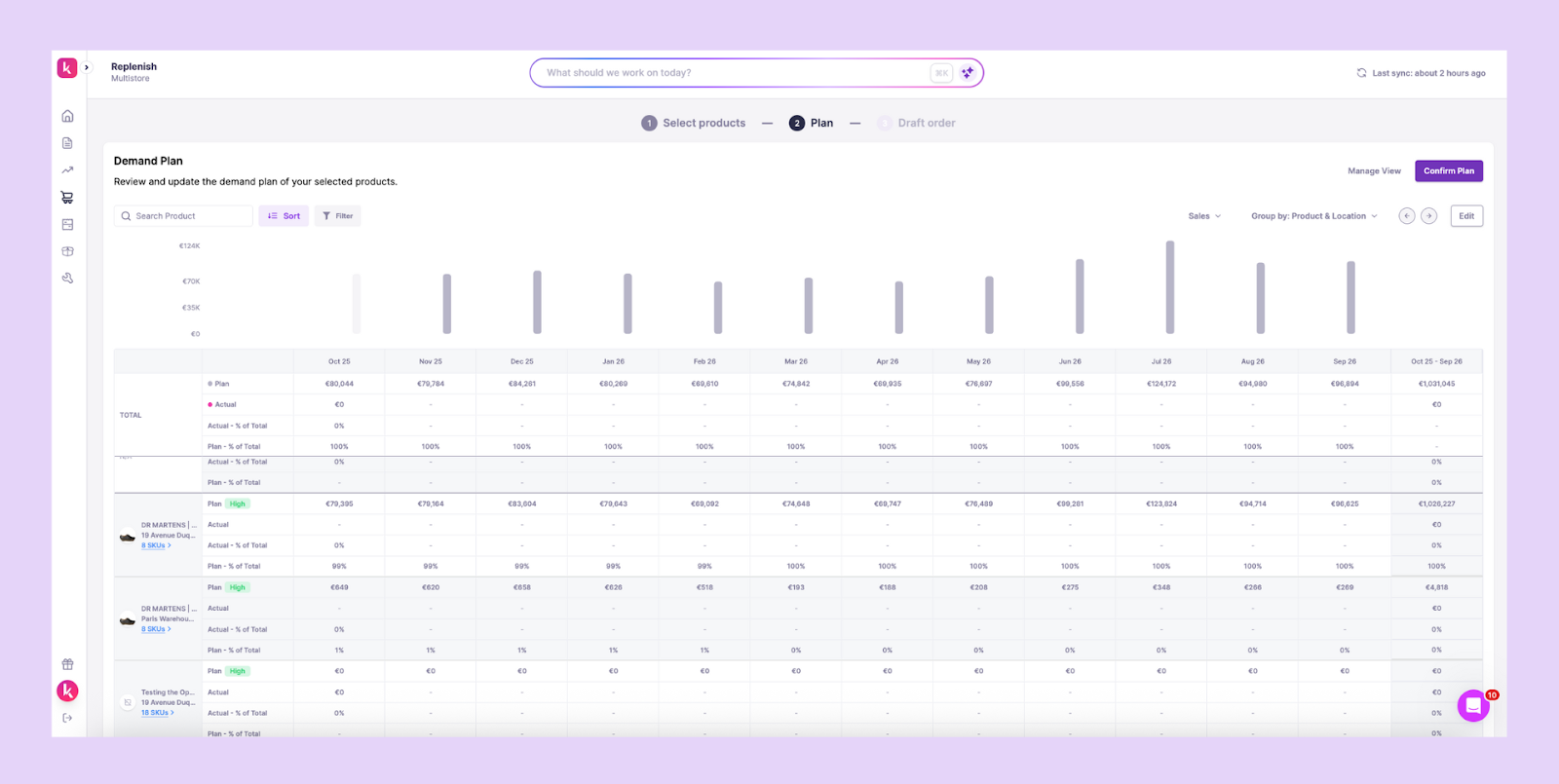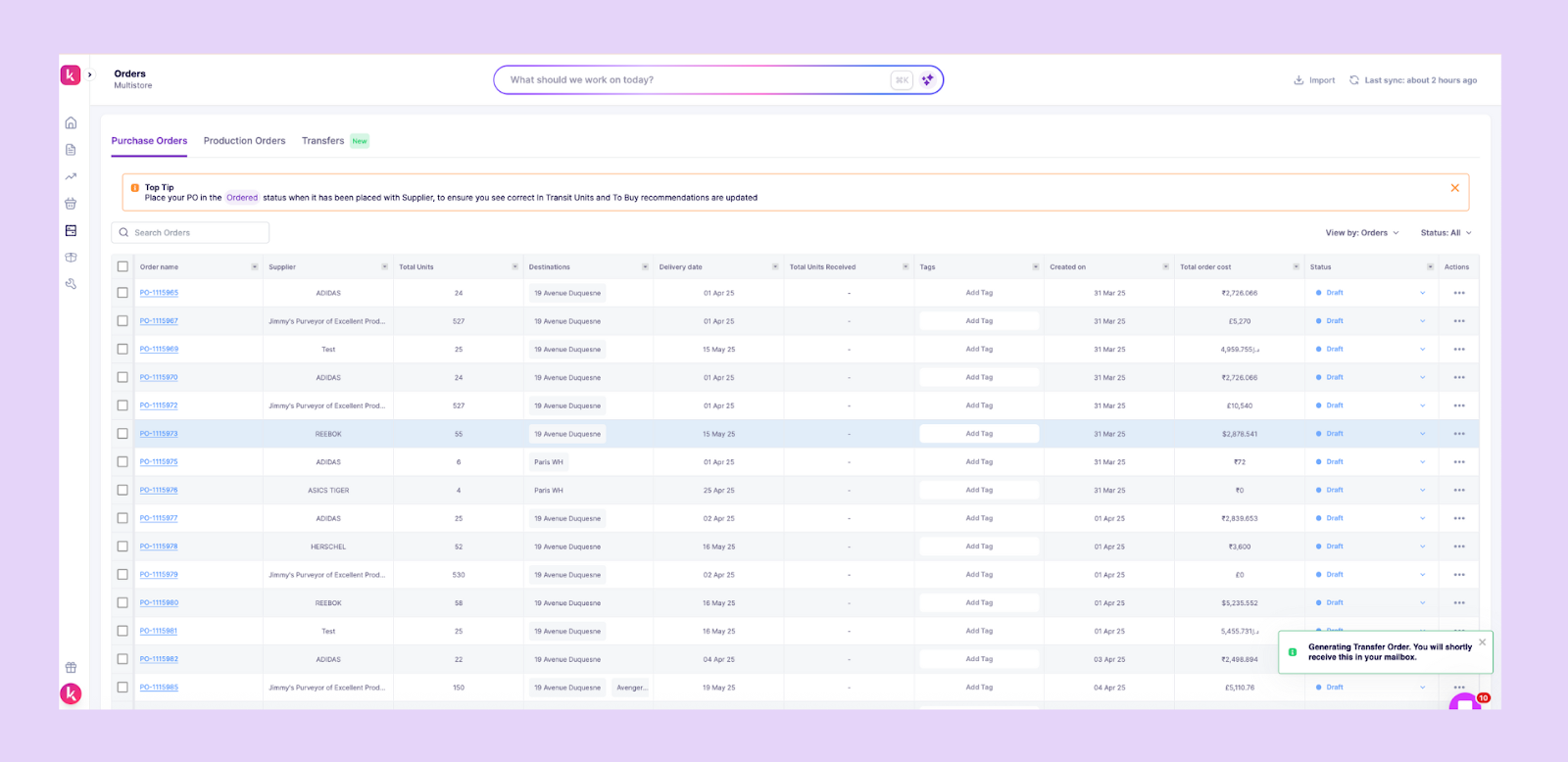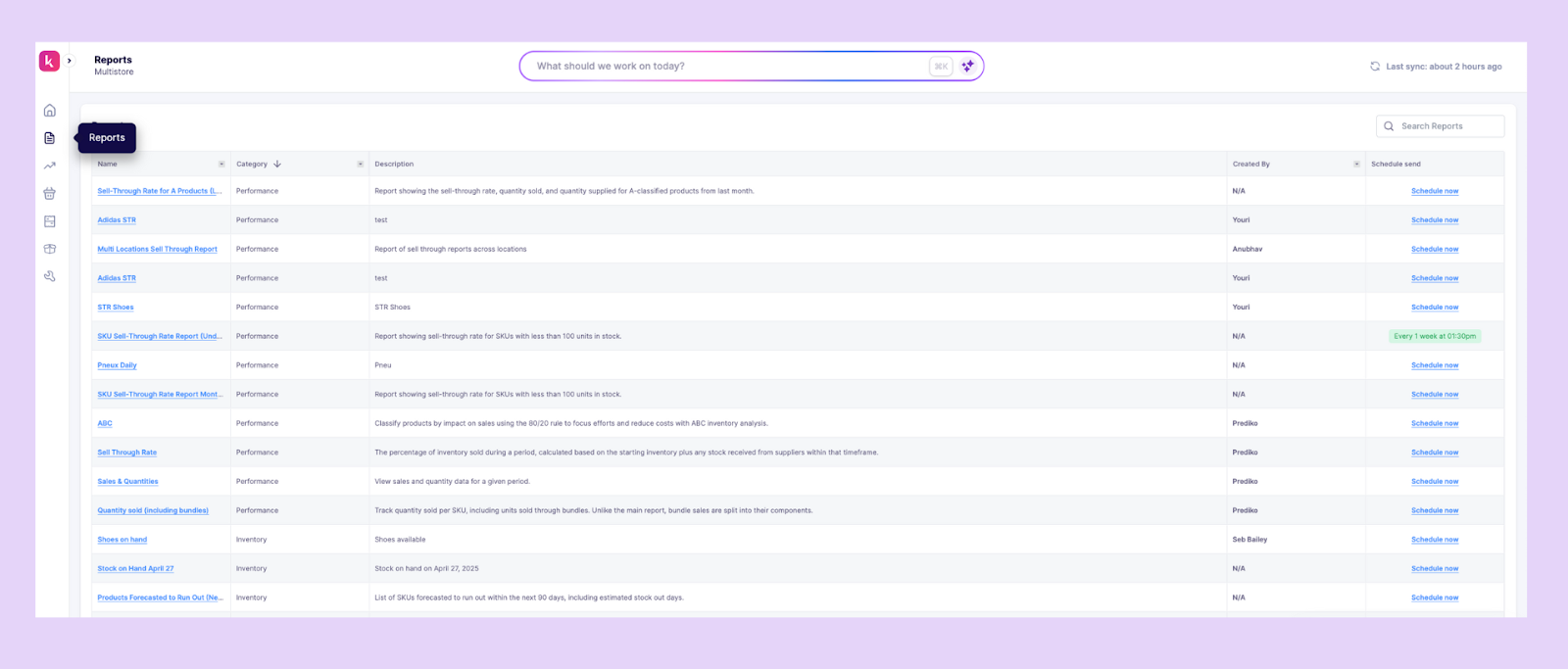When Gareth Southgate, the Three Lions manager, wore a navy polka-dot tie at the Euro 2020, no one expected it to trigger a retail frenzy. Within days, demand for similar ties skyrocketed across the UK.
John Lewis reported that sales of its navy polka-dot tie doubled in a week, while TM Lewin saw a 250 percent increase right after the semi-final.
Moments like these show why traditional forecasting, based on past sales and gut instinct, can’t keep up with real-world unpredictability. Predictive analytics fills that gap by combining data, AI, and external trend signals to anticipate shifts before they happen.
We’ll explain what inventory management predictive analytics is, how it works, and how it helps brands plan smarter, stay agile, and avoid their own “polka-dot tie” moment.
What is Inventory Management Predictive Analytics?
Inventory management predictive analytics is the use of data, statistical models, and AI to forecast future inventory needs with greater accuracy.
It goes beyond traditional reporting by analyzing historical sales, seasonality, lead times, and even external factors like promotions or market trends to predict demand before it happens.
Instead of reacting to what’s already sold, predictive analytics helps brands anticipate what will sell, allowing them to stock the right products, in the right quantities, at the right time.
The result is fewer stockouts, less overstock, and smarter cash flow management across the supply chain.
Why Predictive Analytics is Important in Inventory Management and Forecasting
Acting after the fact often leads to costly mistakes. Predictive analytics in inventory management helps you
1. Reduce stockouts and overstocks
By studying patterns like sales velocity, lead times, and seasonality, predictive analytics anticipates demand well before it happens.
This prevents stockouts, where you lose sales because products are unavailable, and overstocks, where excess inventory ties up cash and storage space.
With accurate predictions, you can order just enough inventory to meet demand, reduce waste, and keep operations running smoothly.
2. Improve forecast accuracy
Traditional forecasting methods rely on historical data and static formulas, which quickly become inaccurate when trends shift.
Predictive analytics, on the other hand, learns dynamically from new data –sales patterns, returns, marketing campaigns, even weather and regional behavior.
This helps you plan purchasing and replenishment with confidence, reducing last-minute adjustments and ordering mistakes.
3. Optimize working capital
Inventory is one of the biggest capital assets in a product business.
Predictive analytics helps you align purchasing with demand so that every dollar in stock is working efficiently.
Instead of bulk-buying to “play it safe,” you maintain lean inventory while still meeting customer demand.
That directly improves liquidity and return on capital employed (ROCE).
4. Tackle operational challenges early
Most inventory issues, like supplier delays or unexpected demand spikes, are visible in data before they become visible in operations. Predictive analytics monitors lead times, stock levels, and PO performance to flag early warnings.
So when a manufacturer starts shipping late or a product suddenly gains traction from a viral post, your system alerts you ahead of time.
That allows you to course-correct with alternate suppliers or safety stock adjustments, avoiding last-minute firefighting.
5. Enable smarter, data-driven planning and forecasting cycles
Every forecasting cycle improves the next one.
Predictive analytics captures learnings from each plan-versus-actual comparison, refining assumptions over time.
Instead of static reorder points or once-a-quarter reviews, you get rolling forecasts that evolve with your sales patterns and marketing performance.
The result is a more agile planning process, one where marketing, finance, and operations align around the same data.
Data and System Requirements to Set Up Inventory Management Predictive Analytics
For predictive models to deliver accurate, timely insights, you need a foundation of complete, high-quality, and continuously updated data. Real-time data keeps predictions relevant as conditions shift across demand, supply, or operations.
1. Types of data you need
A predictive inventory model needs a mix of historical, operational, and external data to forecast accurately. The core inputs include
- Sales history: At least 12–24 months of transaction-level data to identify trends and seasonality
- Lead times: Supplier delivery timelines to forecast reordering needs accurately
- Promotional and marketing data: Campaign periods, discount intensity, and ad spend to correlate sales spikes
- Supplier and purchase data: Vendor reliability, MOQ limits, and past PO timelines
- Product attributes: Category, color, size, or material, since variants perform differently
- External factors: Seasonality, holidays, and market trends that influence demand
2. Cleaning and preparing your data
Before running models, data must be standardized, complete, and consistent. Common errors, like mismatched SKUs, missing lead times, or outdated product IDs, can distort forecasts.
Key preparation steps include
- Normalizing SKUs across Shopify, WMS, and ERP systems
- Filling missing values for supplier or lead time data
- Removing anomalies like one-off bulk orders or canceled transactions
- Ensuring timestamps are uniform (e.g., daily or weekly aggregation)
3. Integration with existing systems
Predictive models work best when integrated directly into your operational tools rather than sitting in isolation. The most effective setups connect with
- Shopify and POS for real-time sales and inventory data
- WMS platforms for warehouse-level visibility
- Marketing tools like Meta or Google Ads for campaign-driven demand shifts
Ultimately, AI predictive analytics for inventory management depends not just on algorithms but on data readiness and interoperability; how well your systems talk to each other and how cleanly they share information.
The more unified your data foundation, the sharper and more reliable your forecasts will be.
Step-by-Step Process for Implementing Predictive Analytics in Inventory Management
The real power of predictive analytics comes from structured execution. Here’s a breakdown of how to move from setup to measurable results.
Step 1: Identify goals and define key KPIs
Before implementing predictive analytics, the first step is to understand what you want to achieve.
Clear goals set the direction for the entire project and determine what data and models you’ll need.
You can start by focusing on measurable outcomes such as reducing stockouts, improving forecast accuracy, or optimizing working capital.
Once goals are established, define the key performance indicators (KPIs) that will track progress. Common KPIs include inventory turnover rate, stockout frequency, forecast accuracy, etc (more on this later.)
These metrics will act as your success benchmarks.
Step 2: Audit data quality and integrations
Before predictive analytics can deliver accurate insights, the data feeding it must be trustworthy. A data audit helps identify gaps, inconsistencies, and integration issues that could distort model outputs or lead to poor decisions.
Start by evaluating your existing data sources
- Check data accuracy and completeness: Look for missing fields, duplicate entries, and outdated information
- Assess consistency across systems: Ensure data formats, naming conventions, and measurement units align between WMS, POS, and inventory platforms
- Review integration points: Confirm that data flows smoothly between systems without lags or manual intervention
Once data is accurate and integrations are reliable, you establish a strong foundation for predictive modeling.
Step 3: Select the appropriate predictive model or software
With clean, connected data in place, the next step is to choose the right model or software for your predictive analytics. The goal is to match the tool’s capabilities to your inventory challenges, data maturity, and available resources.
Start by evaluating what type of model best fits your operations.
- Time-series models work well for stores with consistent, historical sales data and seasonal demand cycles
- Regression models are ideal for identifying relationships between variables like pricing, promotions, and demand
- Machine learning models like Prediko offer advanced AI capabilities, continuously learning from new data to improve forecast accuracy over time
Step 4: Run a pilot with a limited SKU set
Before scaling predictive analytics across your entire inventory, start small. Running a pilot program with a limited SKU set allows you to validate model performance, identify process gaps, and fine-tune parameters without risking large-scale disruption.
Select SKUs that represent a mix of product types: fast-moving, slow-moving, and seasonal items to test how the model handles different demand patterns. Check if it's producing accurate forecasts and sending replenishment alerts for timely action.
Use this stage to gather feedback from involved teams, such as operations, procurement, and demand planning. Their insights will help identify where the system performs well and where adjustments are needed, building confidence in the model’s accuracy.
Step 5: Measure success and scale across product categories
After the pilot, evaluate performance against your original KPIs. Look at forecast accuracy, stock availability, and inventory turnover to see where predictive analytics delivered measurable improvement.
Use the findings to refine model parameters and strengthen your process before scaling. Next, start expanding into additional product categories, applying what worked best during the pilot.
Keep all stakeholders aligned. Share results with supply chain, finance, and merchandising teams so they understand the value and stay engaged as the system grows.
Measuring ROI of Predictive Analytics in Inventory Management
A few key KPIs can help you measure how predictive analytics translates into real business outcomes. Here’s what each metric tracks and how it reflects your system’s impact.
1. Forecast accuracy (%)
When your predictive model is performing well, forecast accuracy is the first metric that reflects it. This shows how closely predicted demand matches actual sales.
Higher accuracy reduces both stockouts and overstocks, leading to fewer missed opportunities and less money tied up in excess stock.
2. Fill rate (%)
Next is the fill rate. A higher fill rate means more customer orders are fulfilled without delay.
Predictive analytics improves this by aligning replenishment schedules with real demand, strengthening customer trust and retention.
3. Inventory turnover ratio
When forecasts are accurate, inventory moves faster.
A higher turnover ratio indicates products are selling efficiently and working capital is being put to use, not tied up in storage.
4. Carrying cost (% of inventory value)
Lower carrying costs are a direct result of accurate forecasting powered by predictive analytics.
By maintaining optimal inventory levels, you spend less on warehousing, insurance, and depreciation, freeing up cash for growth initiatives.
5. Stockout rate (%)
Predictive analytics helps anticipate demand spikes and reorder before they cause shortages.
A lower stockout rate reflects stronger supply continuity, better customer experience, and more accurate predictions.
Common Pitfalls in Inventory Management Predictive Analytics (and How to Avoid Them)
Even with the right tools and data, predictive analytics can fail to deliver results. Below are the most common issues you may face and how to avoid them.
1. Poor or inconsistent data quality
When data from different systems is incomplete or inconsistent, the model’s predictions become unreliable.
Missing sales history, duplicate entries, or mismatched product identifiers can skew predictions and lead to poor decisions.
Solution
- Regularly audit and verify all data sources to maintain accuracy and consistency
- Automate sync between connected systems to eliminate manual updates
- Standardize formats, remove duplicates, and use automated cleaning tools to keep data reliable and ready for analysis
2. Overfitting models leading to unreliable predictions
Overfitting happens when a model learns too much from historical data, performing well on past trends but failing on new scenarios.
This causes inaccurate forecasts when market conditions change.
Solution
To prevent overfitting, simplify your model and regularly validate it against unseen or real-world data.
Continuously retrain models with fresh data (turn on automatic sync) instead of relying solely on historical patterns, and use techniques like cross-validation and regularization to maintain reliability when market conditions shift.
3. Ignoring team training and adoption
Even the most accurate model will not be effective if teams do not understand how to use it. Lack of adoption often results in missed insights and inconsistent decision-making.
Solution
Train all relevant teams, from planners to buyers, on how to interpret and act on predictive insights.
Make analytics a part of daily workflows instead of a separate tool.
4. Not recalibrating models as product mix or seasons change
Demand patterns change constantly. If models are not updated to reflect new products, discontinued SKUs, or seasonal shifts, predictions quickly lose accuracy.
Solution
Schedule regular model recalibrations or plan refreshes.
Incorporate new data sources and adjust parameters before key seasonal cycles or product assortment changes to keep forecasts current and relevant.
How to Choose the Right Predictive Analytics Solution for Inventory Management
Choosing the right predictive analytics solution is important to achieve desired results. The best tools integrate easily with existing systems, scale with your business, and deliver insights your team can act on quickly.
What to look for
Focus on software or a solution that offers
- Accurate models that reflect real-time demand patterns
- Scalability to handle growing data and product lines
- Seamless integration with WMS, POS, and inventory platforms
- User-friendly dashboards that make insights easy to interpret
- Automatic updates or sync as new data becomes available
Questions to ask vendors
Once you’ve shortlisted your options, it’s important to evaluate vendors carefully. During the evaluation phase, make sure to ask the following questions
- Do you provide pilot testing before full rollout?
- Is your pricing transparent, with no hidden fees?
- What customer support and onboarding assistance are included?
- Can your platform integrate with our existing systems easily?
- How often are models retrained or improved?
Selecting a platform that combines accuracy, scalability, and ease of use will help you achieve measurable, long-term results.
Prediko for Predictive Analytics in Inventory Management
Predictive analytics is most effective when it’s seamlessly integrated with real-time inventory data, and that’s exactly what Prediko does.
Built natively for Shopify, Prediko uses predictive AI algorithms to help brands plan smarter, buy better, and operate with complete visibility across their supply chain.
Here’s how Prediko brings predictive analytics to life for growing Shopify brands:
- AI-powered demand forecasting: Prediko’s AI analyzes historical sales, seasonality, sales velocity, and your inputs to generate SKU-level forecasts. These forecasts adapt automatically as new trends or data emerge, keeping predictions accurate and timely.

- Automated purchase order recommendations: Using forecast data and supplier lead times, Prediko predicts when and how much to reorder for each SKU as well as bundles. It then automatically generates and sends POs, helping you restock on time.

- Raw material & production forecasting: For in-house manufacturers, Prediko extends predictive analytics to raw materials. It calculates upcoming material requirements based on finished goods demand for smooth production.

- Smart replenishment alerts: Get notified before issues arise. Prediko flags low stock, overstock, or at-risk SKUs early, letting teams act before it impacts sales or working capital.

- Reporting and analytics dashboard: Prediko turns raw data into actionable reports, from ABC analysis and sell-through rates to stock coverage and COGS trends. You can also schedule these reports to be delivered to your inbox at set times.

- 70+ integrations: Prediko connects seamlessly with WMS, 3PL, and other inventory tools to centralize your inventory data so that every update happens automatically, eliminating manual syncs and data gaps.

Prediko turns predictive analytics into practical, everyday decision-making. Instead of reacting to sales trends after they happen, Shopify brands can anticipate what’s next, keeping inventory lean, cash flow healthy, and growth sustainable.
Start a free 14-day trial and experience the Prediko difference.
.svg)
.png)






